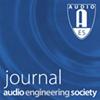基于空间重构的传声器阵列房间脉冲响应绘制
IF 1.1
4区 工程技术
Q3 ACOUSTICS
引用次数: 1
摘要
我们探索了一种基于重建的渲染方法,用于将测量空间的空间特征强加到单音信号上,同时在目标播放设置上再现它。本研究的基础是一个参数化渲染框架,它可以在任意麦克风阵列房间脉冲响应(rir)或双声rir上运行。空间滤波技术用于将输入RIR分解为单个反射和各向异性扩散混响,并使用专用渲染策略进行再现。所提出的方法通过考虑涉及不同呈现配置的几个假设,然后确定哪个假设最忠实地重建输入RIR。就目前的研究而言,这些假设涉及到考虑不同的潜在反射数。一旦确定了要呈现的最佳反射数随时间和频率的变化,用于重建输入RIR的阵列方向响应将被目标播放设置的空间化增益所取代。正式聆听实验的结果表明,与使用已建立的基于子空间的检测算法相比,所提出的方法产生的渲染在感知上更类似于参考响应。与现有的最先进的方法相比,所提出的方法也显示出类似或更好的性能。本文章由计算机程序翻译,如有差异,请以英文原文为准。
Spatial Reconstruction-Based Rendering of Microphone Array Room Impulse Responses
A reconstruction-based rendering approach is explored for the task of imposing the spatial characteristics of a measured space onto a monophonic signal while also reproducing it over a target playback setup. The foundation of this study is a parametric rendering framework, which can operate either on arbitrary microphone array room impulse responses (RIRs) or Ambisonic RIRs. Spatial filtering techniques are used to decompose the input RIR into individual reflections and anisotropic diffuse reverberation, which are reproduced using dedicated rendering strategies. The proposed approach operates by considering several hypotheses involving different rendering configurations and thereafter determining which hypothesis reconstructs the input RIR most faithfully. With regard to the present study, these hypotheses involved considering different potential reflection numbers. Once the optimal number of reflections to render has been determined over time and frequency, the array directional responses used to reconstruct the input RIR are substituted with spatialization gains for the target playback setup. The results of formal listening experiments suggest that the proposed approach produces renderings that are perceptually more similar to reference responses, when compared with the use of an established subspace-based detection algorithm. The proposed approach also demonstrates similar or better performance than that achieved with existing state-of-the-art methods.
求助全文
通过发布文献求助,成功后即可免费获取论文全文。
去求助
来源期刊

Journal of the Audio Engineering Society
工程技术-工程:综合
CiteScore
3.50
自引率
14.30%
发文量
53
审稿时长
1 months
期刊介绍:
The Journal of the Audio Engineering Society — the official publication of the AES — is the only peer-reviewed journal devoted exclusively to audio technology. Published 10 times each year, it is available to all AES members and subscribers.
The Journal contains state-of-the-art technical papers and engineering reports; feature articles covering timely topics; pre and post reports of AES conventions and other society activities; news from AES sections around the world; Standards and Education Committee work; membership news, patents, new products, and newsworthy developments in the field of audio.
 求助内容:
求助内容: 应助结果提醒方式:
应助结果提醒方式:


